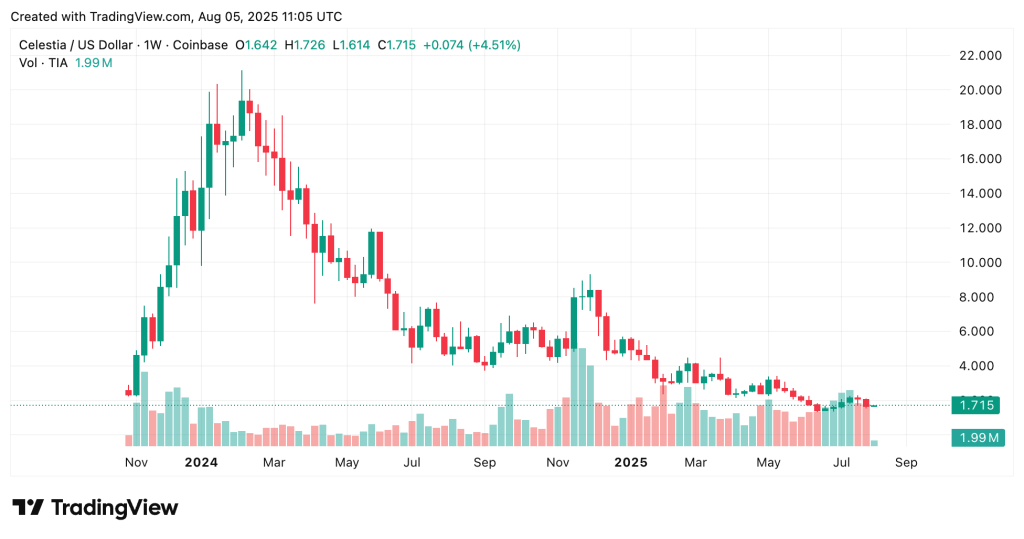
Once hailed as the poster child of the “modular blockchain” movement, Celestia’s native token TIA has plummeted over 90% since its 2024 peak. While initially riding the hype of a massive airdrop and promises of decentralization, the token’s steep decline is now raising uncomfortable questions about tokenomics, aggressive unlocks, and venture capital exit strategies.

Launched with significant community backing in late 2023, Celestia’s TIA token was distributed to 580,000 users through one of the largest airdrops in recent memory. TIA surged to $20 in September 2024, fueled by optimism around Celestia’s architecture and adoption prospects.
However, as vesting cliffs began to expire, large volumes of previously locked tokens entered circulation. According to Tokenomist data, many of these belonged to early backers and core contributors, including venture capital firms that had acquired TIA at deep discounts during early fundraising rounds.
The result was a flood of sell pressure. As these tokens hit the open market, TIA’s price collapsed, reaching lows of just $1.65, a drop of over 90%. Despite this, the token’s market cap rose by 50%, now hovering around $1.2 billion.
Polychain Exit and Celestia’s Attempt to Regain Control
The tipping point came in July when one of Celestia’s most prominent backers, Polychain Capital, divested entirely from the project. The Celestia Foundation announced a $62.5 million buyback of Polychain’s entire remaining TIA holdings, priced at approximately $1.44 per token, near its market rate at the time.
In an effort to stabilize the token economy, the foundation plans to redistribute the repurchased tokens under a new rolling unlock schedule, starting August 16 and concluding November 14. The revised structure is part of a broader strategy to manage inflation and repair investor trust.
Criticism had been building around Polychain’s handling of staking rewards. Despite their initial investment still being under lock, on-chain analysts estimate the firm offloaded more than $240 million worth of TIA, primarily from staking yield. The heavy sell-offs were seen by many as exploiting loopholes in the reward system, disproportionately benefiting early insiders at the expense of retail participants.
In response, Celestia introduced a staking reform as part of its upcoming “Lotus” mainnet upgrade. The update implemented a lock mechanism in which early investors will no longer be able to cash out staking yields prematurely, ensuring that reward access is aligned with long-term commitment to the network.
From Blast to Bust: TIA Crash Indicates Fragility of New Tokenomics
The recent plunge in Celestia’s TIA token price mirrors a broader pattern plaguing newer Layer 1 and Layer 2 projects, where aggressive unlock schedules and liquidity mismanagement dismantle early hype.
The most striking collapse came from Blast, which initially attracted over $2.7 billion in Total Value Locked (TVL), becoming the sixth-largest blockchain within six months. At its peak, it boasted more than 200 deployed dApps and 180,000 daily active users. But the momentum was short-lived.
A massive June 2024 unlock, over 10.5 billion tokens, accounting for more than half its supply, flooded the market, crashing prices to all-time lows. As of today, TVL has cratered by over 96% to just $105 million, with daily activity down to 3,800 users.
Also, Berachain suffered a 50% price drop within hours of launch amid insider trading accusations and an unpopular airdrop that saw some users receive millions while others got nothing.
Similarly, Omni Network’s token fell over 50% on launch day. With another 15.98 million OMNI unlocking on May 3, worth nearly $40 million at current prices, the bearish trend seems likely to continue. OMNI has already lost over 92% from its all-time high of $53.81.
These failures underscore a growing skepticism around newer tokens that prioritize early liquidity and inflated valuations over sustainable ecosystem growth.
Token Unlocks Continue to Pressure Market as Major Projects Brace for Volatility
The crypto market is preparing for another turbulent week as major token unlocks threaten to shake investor sentiment. Between August 4 and August 10, 2025, several high-profile projects, such as Ethena (ENA), Jito Labs (JTO), and Immutable (IMX), will release millions in tokens, potentially creating fresh waves of volatility.
Ethena tops the list with a scheduled unlock of 171.85 million ENA tokens on August 5, worth an estimated $101.87 million, or 2.70% of its market cap. ENA’s price has already slipped -61.43% from its all-time high of $1.52 and is now trading at $0.5883. The project previously conducted a widely followed airdrop in April 2024, distributing 750 million tokens to participants. However, the fresh supply could pressure prices further if recipients decide to sell into the unlock.
On August 7, Jito Labs will release 11.31 million JTO tokens, worth $19.07 million and accounting for 3.14% of its market cap. The Solana-based DeFi project distributed around $225 million worth of tokens during its December 2023 airdrop. Since then, JTO has fallen -70.13% from its all-time high of $5.61, currently trading at $1.69, raising concerns about continued downside risk.
Immutable will unlock $12.15 million worth of IMX tokens on August 8, or 1.30% of its market cap. While over 95.1% of IMX’s total supply has already been released, the unlock still matters, as IMX has plummeted -94.57% from its peak of $9.50 and is now trading at just $0.5173. IMX’s token dynamics reflect the trend seen across many airdrop-heavy projects—brief initial hype followed by sharp post-unlock sell-offs.
These upcoming unlocks come at a time when market confidence in airdrop-distributed tokens continues to falter. With airdrop recipients often acting as aggressive sellers, future unlocks, especially in a bearish or sideways market, could exacerbate downward pressure across the altcoin sector.
Credit: Source link







